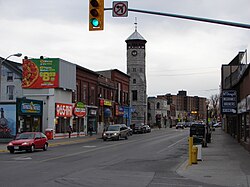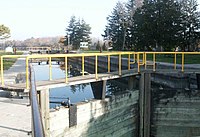| Revision as of 21:37, 9 January 2008 editHaemo (talk | contribs)17,445 editsm Changed protection level for "Trenton, Ontario": Full protection: Vandalism. (expires 21:37, 23 January 2008 (UTC))← Previous edit | Revision as of 21:37, 9 January 2008 edit undoMastCell (talk | contribs)Edit filter managers, Administrators43,155 editsm semiprotection templateNext edit → | ||
| Line 1: | Line 1: | ||
| {{pp-semi-vandalism|small=yes}} | |||
| {{Infobox Settlement | {{Infobox Settlement | ||
| <!--See Template:Infobox Settlement for additional fields that may be available--> | <!--See Template:Infobox Settlement for additional fields that may be available--> | ||
Revision as of 21:37, 9 January 2008
| Trenton | |
|---|---|
| Community | |
 Dundas Street, the main road in Trenton, Ontario. Dundas Street, the main road in Trenton, Ontario. | |
| Country | |
| Province | |
| County | Hastings |
| City | Quinte West |
| First Settled | 1784 |
| Incorporated (village) | 1853 |
| Incorporated (town) | 1880 |
| Population | |
| • Total | 19,374 |
| Time zone | UTC-5 (EST) |
| • Summer (DST) | UTC-4 (EDT) |
| Postal Code FSA | K8V |
| Area code | 613 |
| Website | http://city.quintewest.on.ca |
Trenton, Ontario (2001 population 19,374) is a community on the Bay of Quinte. It is the main population centre in the municipality of Quinte West, Ontario, Canada.
Trenton is situated on the Bay of Quinte and is the starting point for the Trent-Severn Waterway which continues northwest to Peterborough and eventually Port Severn on Georgian Bay.
History
The Trent River was known to the Mississauga as Sangichiwigewonk, or 'fast flowing.' It was named after the River Trent in England.
French explorer Samuel de Champlain followed the Trent Severn passing through Trenton in 1615. The area around the mouth of the Trent River was first settled by Europeans in the 1780s. Assorted settlements and town plots in the area went under a number of names, until the Village of Trenton was incorporated in 1853. Trenton grew thanks to its port location and area lumber industry. During the First World War, the town was home to a a major munitions plant owned by the British Chemical Company. This facility was destroyed in a major explosion in 1918.
Trenton was also an important film production centre. In 1917, a film studio was built in the town and a number of productions were filmed there. In 1923, the Trenton Film Plant was purchased by the Ontario government to house the studio and laboratory of the Ontario Motion Picture Bureau. The advent of talkies and 16mm film made the equipment at the film plant obsolete and the facility closed in 1934.
The construction of a RCAF Station Trenton, a major Royal Canadian Air Force base just east of Trenton started in 1929 and continued through the 1930s. This provided a major economic boost to the area through the Great Depression, the Second World War and after.
Trenton was incorporated as a city in 1980. On January 1st, 1998, Trenton was amalgamated with the Village of Frankford and the Townships of Murray and Sidney to form Quinte West. Home to nearly half the population of Quinte West, Trenton is the largest community within the municipality.
Economy
Canadian Forces Base Trenton/8 WING, located on the east side of the town, is an important facility for Canadian Forces Air Command's transport and search and rescue operations, and is Trenton's main employer. The base is currently being renovated to include a new air traffic control tower and parking for the new CC-177 Globemaster III aircraft deployed there.
Other large employers include Quaker Oats, Norampac, TeleTech, Nestlé, Tyco Thermal Controls and Wal Mart.
Tourism also plays an important role in the economy, given Trenton's location as the southern entry point for the Trent-Severn waterway.
Transportation
Highway 401 crosses the Trent River on the north side of the town. Hastings County Road 2 (formerly Ontario Highway 2) is the main east-west route through town leading towards Brighton in the west and to Belleville in the east.
Canadian Pacific and Canadian National main railway lines (Toronto – Ottawa/Montreal) pass through the city. VIA Rail offers limited passenger service to Trenton Junction station.
Trenton Airport is co-located with CFB Trenton on the east side of town.
Trenton is the starting point for the Trent-Severn Waterway and two locks (Lock 1 and Lock 2) are located in the community.

Recreation & Culture
Trenton is located on the Lake Ontario Waterfront Trail. Surrounding Trenton, there are numerous conservation areas, campsites, picnic grounds, and marinas. The area boasts nine golf courses, 3 ice hockey rinks, numerous soccer fields, many kilometres of walking trails, a dog park, curling rinks, baseball diamonds, amongst many other recreational activities. Trenton also serves as a gateway to Prince Edward County, located just to the south of the Bay of Quinte. This area is becoming increasingly well known for its many vineyards, excellent camping, beaches and boating.
Trenton is the site of the RCAF Memorial Museum which is the home of an original Canadian Halifax Bomber, the 75th RCAF time capsule, as well as many other interesting aircraft and historical information.
Every summer CFB Trenton also is home to hundreds of Royal Canadian Air Cadets who attend 2 week Familiarization Courses, 3 week Introductory Specialty Courses, and 6 week Advanced Specialty Courses, and has special staff positions for more senior cadets. These summer courses introduce the cadets to a military learning environment that promotes discipline, teamwork, and fun. Most camps here also go on trips to the airport, the Air Museum, and other relevant places.
Trenton is a hot spot for sport fishing. Popular freshwater fish in the Bay of Quinte and the Trent River include walleye (pickerel), bass, pike, perch, and mudcat. During particular times of the year, salmon and rainbow trout can be caught in the Trent River and in cold water streams in the area. Each year in May, the Kiwanis Club of Trenton holds the Annual Live Release Fishing Derby attracting thousands of sport fishermen from around North America with major prizes for tagged fish and heaviest weighed walleye and Northern pike.
In 1990, Canadian poet Al Purdy published his only novel "A Splinter In The Heart". It takes place entirely in Trenton and provides a nice historical look of the town. It mentions many of the landmarks in the city (Mount Pelion, The Bridges, Trent River, etc.) and documents the period of the town directly before and after the huge dynamite factory explosion of 1918.
Notable People
- Mel Bridgman, hockey player
- John Garrett, former NHL Goalie and hockey announcer.
- Steve Graves, hockey player
- Elizabeth Manley, 1988 Olympic figure skating silver medalist
- Steve Smith, hockey player
External links
References
- Rayburn, Alan. Place Names of Ontario. Toronto : University of Toronto Press, 1997. ISBN 0-8020-7207-0.
- Quinte West Tourism retrieved 2007-10-30
44°06′00″N 77°34′50″W / 44.10000°N 77.58056°W / 44.10000; -77.58056
Categories: